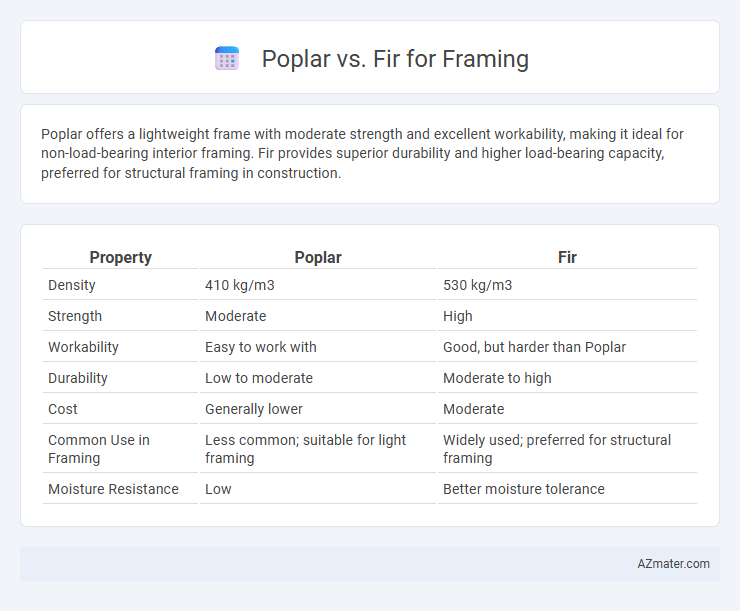Poplar offers a lightweight frame with moderate strength and excellent workability, making it ideal for non-load-bearing interior framing. Fir provides superior durability and higher load-bearing capacity, preferred for structural framing in construction.
Table of Comparison
| Property | Poplar | Fir |
|---|---|---|
| Density | 410 kg/m3 | 530 kg/m3 |
| Strength | Moderate | High |
| Workability | Easy to work with | Good, but harder than Poplar |
| Durability | Low to moderate | Moderate to high |
| Cost | Generally lower | Moderate |
| Common Use in Framing | Less common; suitable for light framing | Widely used; preferred for structural framing |
| Moisture Resistance | Low | Better moisture tolerance |
Introduction to Poplar and Fir for Framing
Poplar is a lightweight hardwood known for its straight grain and moderate strength, making it a cost-effective option for framing where weight is a consideration. Fir, particularly Douglas Fir, is a strong softwood favored in construction for its superior load-bearing capacity and durability in framing applications. Both woods offer distinct advantages, with poplar excelling in ease of machining and fir providing enhanced structural integrity for building frames.
Wood Characteristics: Poplar vs Fir
Poplar wood is lightweight and moderately strong with a fine, consistent grain, making it easy to work with but less durable than fir for structural framing. Fir, specifically Douglas fir, offers superior strength, stiffness, and resistance to warping, making it a preferred choice in heavy framing applications requiring long-lasting support. The natural durability and higher density of fir contribute to better load-bearing performance and enhanced resistance to decay compared to poplar.
Strength and Durability Comparison
Poplar wood offers moderate strength with a Janka hardness rating of about 540 psi, making it less ideal for heavy structural framing compared to fir, which typically has a higher strength rating around 1,100 psi and greater load-bearing capacity. Fir's superior durability and resistance to warping and splitting make it a preferred choice for long-lasting, stable framing in construction. When evaluating framing materials, fir's enhanced strength and durability contribute to better performance under stress, while poplar is more suited for non-load-bearing or interior applications.
Workability and Ease of Use
Poplar offers excellent workability with a fine, uniform texture and minimal grain irregularities, making it easy to machine, sand, and nail for framing applications. Fir is slightly more challenging due to its resinous knots and uneven grain, but it remains a popular choice because of its strength and moderate workability. Both woods are favored for framing, yet poplar's smoother finish enhances ease of use, especially for precision cutting and fastening tasks.
Cost Differences: Poplar vs Fir
Poplar framing lumber typically costs less than fir, making it a more budget-friendly option for construction projects. Fir, known for its strength and durability, commands a higher price due to its superior load-bearing capacity and resistance to warping. Cost differences between poplar and fir can impact overall project budgets, especially in large-scale framing applications where material quantity significantly affects expenses.
Availability and Sourcing
Poplar offers consistent availability in North America, primarily sourced from the eastern United States, making it a reliable choice for framing projects in nearby regions. Fir, especially Douglas Fir, is widely available across the United States and Canada, with extensive harvesting operations ensuring a steady supply for construction framing. Both woods benefit from established distribution networks, but fir's larger-scale commercial production often results in more competitive pricing and broader sourcing options.
Resistance to Decay and Insects
Poplar exhibits moderate resistance to decay and insect damage, making it less durable for framing in high-moisture or termite-prone areas compared to fir. Fir, particularly Douglas fir, offers superior natural resistance to decay and insect infestation, enhancing the longevity of structural frames. Selecting fir for framing projects ensures better durability and reduced maintenance in environments susceptible to wood deterioration.
Environmental Impact and Sustainability
Poplar wood offers a significantly lower environmental impact compared to fir due to its faster growth rate and higher carbon sequestration potential, making it a more sustainable choice for framing. Fir, while durable and strong, typically requires longer growth periods and contributes to slower forest regeneration. Choosing poplar supports sustainable forestry practices by reducing deforestation pressure and promoting renewable timber resources in construction.
Best Applications for Poplar and Fir in Framing
Poplar is best suited for interior framing applications due to its lightweight nature and ease of machining, making it ideal for non-load-bearing walls and decorative trims. Fir is preferred in structural framing because of its strong tensile strength and resistance to warping, which provides reliable support in load-bearing walls and heavy construction projects. Using poplar in areas where weight reduction and smooth finishes are prioritized complements fir's role in ensuring durability and structural integrity.
Conclusion: Choosing the Right Wood for Your Project
Poplar and fir both offer distinct advantages for framing; poplar is lightweight and easy to work with, while fir provides greater strength and durability. Fir is typically preferred for structural framing due to its superior load-bearing capacity and resistance to warping. Selecting fir ensures long-lasting support, making it the ideal choice for most construction projects requiring reliable framing wood.

Infographic: Poplar vs Fir for Framing
 azmater.com
azmater.com